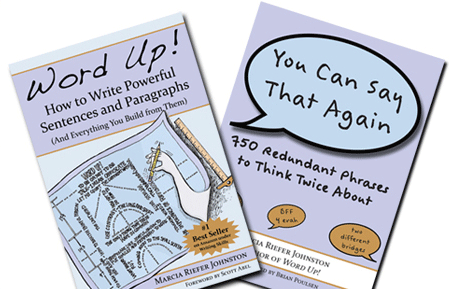“It’s hard to keep all the rules in mind while I’m writing,” writes fellow blogger Elizabeth.
It’s not hard. It’s impossible.
Well then what should be happening in your mind as you write? My answer involves seeing and seeing and seeing again. But before I can answer, I have to address a bigger question…
How does the creative mind work?
One way to explore this question is to observe designers as they sketch. Gabriela Goldschmidt, who wrote the 1991 article The Dialectics of Sketching, did just that.[1]
Goldschmidt analyzed the comments that architects made as they sketched during the early stages of designing. She discovered that the sketchers’ thoughts followed a “pendulum pattern,” a “swaying movement” between two kinds of seeing: “seeing as” and “seeing that.”
She developed a way of depicting this mental cycle, this “ping-pong pattern” between “as” and “that” modes of seeing. Her depictions look something like this:

Seeing as, seeing that, seeing as, seeing that.
When the architect is “seeing as,” something in the sketch reminds him of another thing. For example, as he sketches a library, he might see a group of shapes as a puzzle, or a series of aligned items as an axis, or a certain spot as a dome.
In “seeing that” mode, the architect uses a “nonfigural” eye. He sees in terms of “generic architectural rules” or “design values and beliefs.” He might see that a building needs a strong relationship to its site, or that trees are important because they provide shade, or that an atrium would be appropriate.
Each kind of seeing — as and that — informs the other. Back and forth.
All the while, the architect sketches. He erases. He adds squiggles. He pauses. Insight by insight, the architect ushers his rendering of library and grounds to a point of satisfaction.
What does all that have to do with writing?
Goldschmidt makes no claims about what goes on in writers’ minds, but she acknowledges that “‘seeing as’ and ‘seeing that’ are not unique to sketching.” I believe that words (which came into the world as squiggles) can stimulate what Goldschmidt calls “visual thinking” or “design reasoning” as much as any picture can.
Do words do this for you? Do the “dialectics of sketching” resonate with the way you write?
I’ve been told that most people would say No. Maybe you wonder why I’m bothering with this topic.
I’ll tell you why. This back-and-forth process — my own kind of “sketch-thinking” — drives my best, most satisfying writing. It’s here, between ping and pong, that the good stuff happens. When people talk about craft, this is what they’re talking about.
How does the dialectic (as-that) process apply to words?
As I experience it, “seeing as” amounts to seeing a particular word or group of words as another thing. That thing might not be visual (“figural” as Goldschmidt would say), but when you’re in this mode, your mind, like a sketcher’s, generates an equation. Your brain equates something you’re looking at with something else. In the instant that your eye lands on a word or group of words, you involuntarily make the connection — so fast that you don’t even realize you’re thinking, “Hey, this reminds me of… [fill in the blank].”
For example, you might look at the word t-r-e-e and see it as a noun (a grammatical equivalent). You might see the same word, tree, as a family (a metaphorical equivalent). You might see a paragraph as an introduction (a functional equivalent).
In other words, the “as” is an equal sign. That fill-in-the-blank thing on the other side of the equation carries with it unavoidable fresh knowledge. Everything you know about nouns or families or metaphors or introductions suddenly comes to bear on what you’re writing. New possibilities emerge.
In this way, each flash of “seeing as” insight moves your writing forward.
When you’re “seeing that,” you see instead in terms of rules, values, and beliefs about what constitutes good writing. You might see that singular nouns need singular pronouns, or that all metaphors involve both similarities and differences, or that an introductory paragraph should snare the reader’s interest.
Each “seeing that” flash moves you forward too, prompting you to correct an error, to expand an idea, to add what you hope will be an irresistible opening line, or perhaps to see another word as something else… and on and on.
When I’m “in the zone,” I oscillate between “as” and “that” a lot. A whole lot.
Should everyone write everything in this sketch-y way?
Neeeeeeeeew. Sometimes it’s appropriate to jot down words as they come to mind and leave them pretty much alone. Minimal tampering. Get ‘er done. You’re wasting time if you belabor transitory messages — emails, for example (not counting the ones asking for a raise).
The same is true for sketching. Outside of the design context, people often simply “represent images held in the mind,” as Goldschmidt puts it. They stop there. Even a master architect grabs a paper napkin and tosses off a map to his (painstakingly designed) house without a single as-that blip. No design thinking is required.
At its extreme, that kind of nondialectic sketching or writing looks like this:

It takes discernment to determine how flat or bumpy your line should be for the job at hand. For some of us, it also takes self-control (sometimes more than I possess) to revise — as in re-vise, see again differently — only as much as is warranted.
How do I get in the game?
You’re ready to ask for that raise. You’re in the ping-pong game. How do you play it?
It’s not like you can flip from one kind of writerly seeing to another at will or in strict alternating order. “Time to put on your seeing that glasses, everyone!” Uh… no. But you do want to be adept, and keep getting adepter, at using different kinds of eyes.
How? By looking. Look at words. Look and look and look again. Play with them. Swat them with your left hand, swat them with your right. Bone up on your bdelygmia skills.[2] Get your Garner on.[3] Embrace your inner word nerd. Whatever you’re reading, watch for what works and what doesn’t. Figure out for yourself why or why not.
And keep reading my blog. Subscribe even. (See that little white “Sign me up!” button? Over there, at the top right.)
Before long, you’ll be lobbing away with the best of them. Now, you notice a grammatical problem that needs fixing. Now, a metaphor suggests itself. Now, you’re hearing the voice of Mr. Fitz, your eighth-grade English teacher, telling you that your ending should hark back to your beginning.
So, Elizabeth, the pressure’s off. All you need to keep in mind when you write is one thing at a time. The trick is to keep looking. There is always more to see.
—
[1] The Dialectics of Sketching appears in the Creativity Research Journal, 4: 2, 123–143.
[2] Bdelygmia: The Perfect Rant
[3] Sign up for Bryan Garner’s Tip of the Day. Buy Garner’s Modern American Usage.










